Vulnerable birds in Charleston County may lose more than half of their current range as they are forced to search for more suitable habitat and climate conditions elsewhere, according to a nationwide climate report released by Audubon in October 2019.
The climate impact study, entitled “Survival by Degrees: 389 Bird Species on the Brink,” provides a detailed look at the impact of climate change on birds and the overall health of our environment.
To develop the report, Audubon scientists compiled more than 140 million observations recorded by birders and scientists to describe where 604 North American bird species live today, also known as their “range.” They then incorporated the latest climate models from the Intergovernmental Panel on Climate Change (IPCC) to project how each species’ range may shift under different projected warming scenarios, based on what these birds need to survive, explained Matt Johnson, Center Director of the Audubon Center and Sanctuary at Beidler Forest in Harleyville.
Big picture, it found that nearly two-thirds of North American bird species (389 out of 604) studied are considered vulnerable and could face extinction by 2100 unless immediate action is taken to curb climate change. This vulnerability is determined by their entire range.
Johnson emphasized though that it is not all doom and gloom. This projection examines a worst-case 3 degrees Celsius warming scenario in which no changes are made to mitigate climate change effects.
“If we keep global temperature change to 1.5 degrees Celsius, things look better for all of our birds. The main takeaway is our birds are threatened by climate change and we need to act now.”
The report shows that nearly 20 percent of South Carolina’s 236 bird species included in the study were identified as vulnerable to climate change and are likely to experience range shifts. Breeding birds could be disproportionately affected—nearly a quarter (35 out of 146) of species that nest in South Carolina during summer are climate vulnerable. If conditions change, there may not be enough resources to breed here.
“South Carolina is an important nesting ground for so many species,” stated Johnson.
The Brown-headed Nuthatch is another bird found locally that could be vulnerable across their range, of which South Carolina comprises a big chunk. The birds prefer living in open pine forest habitat and have a distinguishing call resembling a “dog chewing on a squeaky toy,” noted Johnson.
There are also birds sighted here only during winter, such as the tundra swan, whose winter range may be impacted by rising temperatures. Tundra swans nest far up north in threatened areas like the Arctic National Wildlife Refuge but migrate as far south as South Carolina in winter.
“It’s amazing that birds found in the Arctic are found here in South Carolina,” commented Johnson. “Technology is now allowing us to study birds like never before.”
While the main threats from climate change in South Carolina are sea-level rise, flooding, and extreme weather events, Johnson added that is important to understand that birds face multiple threats in addition to climate change. Many species are already threatened by habitat loss or human disturbance, including shorebirds like the piping plover (considered vulnerable in the context of this report) that winter in our state and can be spotted in Mount Pleasant and the islands.
The Canary in the Coal Mine
So why should you care about a Brown-headed Nuthatch? Because birds are an indicator of the overall health of our environment. The same climate change-driven threats that put birds at risk harm humans too.
“An important point we try to make in the study is that these are issues that will affect people too,” remarked Johnson. “It’s like the canary in the coal mine. Birds are sentinels of environmental change.”
He cited the pesticide DDT as an example, which at one time decimated bald eagle and other raptor populations before its link to their declines alerted people to its environmental impacts, leading to an eventual ban.
Although dire, the study predictions are not a foregone conclusion. The report indicates that if we take action now, we can improve the chances for 76 percent of bird species at risk.

Audubon offers several ways to get involved, including advocating for clean energy policies that help birds such as 2019’s SC Energy Freedom Act supporting solar technologies.
You can also protect local places that birds need like the Patriots Point Nature Trail, which Johnson identified as a critically important food stopover for migrating birds that use it to fuel up for their long journeys.
Another step anyone can take is planting native and advocating for native plants.
“Mount Pleasant does a good job of this already,” said Johnson.
Non-native plants do not provide any resources for birds, which are adapted to native plants, either to the fruits or insects they provide.
“Planting native is a good way to create habitat for these birds as they adapt to climate change,” explained Johnson.
As a bird watcher, you can play a vital citizen science role through reporting the birds you encounter in a particular area, whether as part of a local or global bird count initiative or simply a day of documenting what you see at Pitt Street Bridge or Sullivan’s Island Nature Trail through the eBird app.
Scientists and researchers around the world use eBird to study trends and how bird populations are faring, noted Johnson. “It provides valuable data.”
Access the Audubon report online at audubon.org/climate/survivalbydegrees and use the Birds and Climate Visualizer tool to learn more about how birds found here either year-round or seasonally could be affected.






